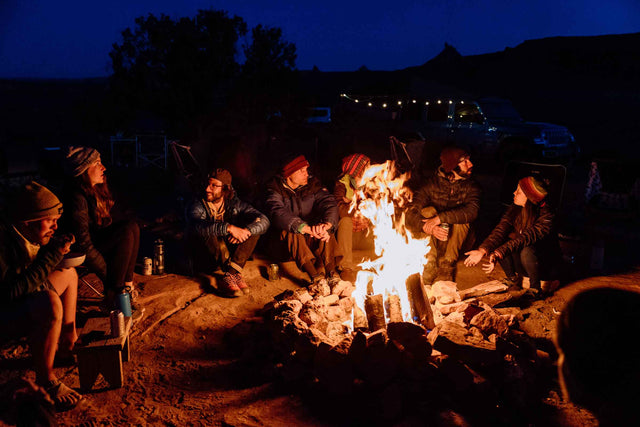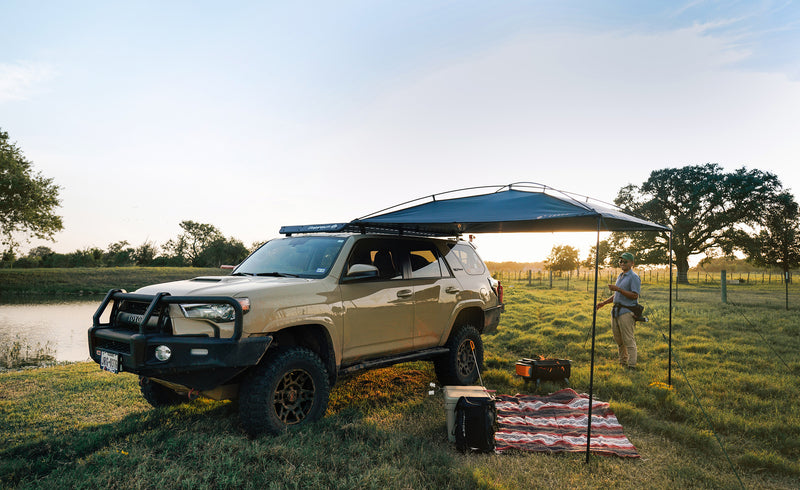MoonShade Pro Tips: Optimizing Your Camp Setup
Take your MoonShade game to the next level with pro tips from Moon's resident gear guide, Seb
by Seb Cancino

When setting up MoonShade, finding the optimal position for your vehicle or camper is crucial for peak enjoyment of your outdoor space. Every campsite, developed or not, is different and requires a bit of work to create your ideal area for relaxing, playing, or working. Whether your priorities are shade from the sun, protection from wind and precipitation, or your personal privacy, much can be done to improve the livability of your site and to maximize MoonShade’s utility.
Check out our tips below for orienting your vehicle or camper when using MoonShade to take your campsite game to the next level!
Sun
MoonShade is primarily a sunshade, so first think about where the sun will be throughout the day and how much sun you want in your space. MoonShade does the heavy lifting to protect your site, but a bit of planning can allow for maximum shade for your activity.
- In the northern hemisphere, the sun mainly shines from the south. If you want more sun, position your MoonShade to the south, and to the north if you want less sun. (Think the opposite if you’re in the southern hemisphere).

- The sun moves east to west throughout the day (in both hemispheres). If you want morning sun with afternoon shade (great in the heat), position MoonShade facing east, and to the west if you want the opposite.
- Low-angle sun got you hot around the collar? As the sun moves throughout the day, try adjusting the length of MoonShade’s support poles up or down to achieve the optimal angle. (Check for taut guylines).
- Still need more protection from side sun? Try MoonWall in Long or Short for more shade and privacy in your outdoor space.

Wind
Wind is the arch nemesis of all awnings, but secure anchors, guylines with stakes, and a bit of planning can keep you enjoying MoonShade longer.
- Determine the prevailing direction of wind in your camp. By large bodies of water, wind frequently blows toward shore. In a canyon, wind may blow parallel to canyon walls. Lick your finger and stick it in the air if you have to.
- If your site allows, try placing your vehicle so that wind will blow toward the side opposite of MoonShade (the leeward side). This allows wind to blow over the vehicle and across MoonShade’s canopy and lessens the chance of the awning becoming a sail. This will also protect you more from blowing precipitation.

- Can’t position your vehicle as in the image? Add a guyline to MoonShade on the side where the wind is blowing in. Optionally, shorten the support pole on this side to allow wind to blow over MoonShade’s canopy.
- At the end of the day, you and your crew’s safety and the longevity of your gear are most important. No awning is made to withstand high, gusty, or extreme winds and weather. Be conservative and take MoonShade down if the wind picks up. You (and your wallet) will thank us.

Privacy
If sun position and wind aren’t a primary concern at camp, consider if you want a front porch to greet folks on the campground loop or if you want a private space for quiet living and few guests.
- This is where MoonWall really shines! Add MoonWall Long or Short to your MoonShade to enclose your MoonShade area and keep wandering eyes out of your campsite.
- When setting up camp, try to position the side of the vehicle with MoonShade facing into your campsite and away from the road. This will automatically offer more privacy inside the vehicle.
- Need privacy but want to keep your sliding door open? Remove MoonShade’s upright poles and swing the shade canopy down to create a temporary sheltered space for changing, resting, or cooking. (Add stakes for security).

Rain
MoonShade is still your favorite sunshade, but it’s built to keep you dry in light precipitation. Try these tips for improving your MoonShade experience in rain and other light precipitation.
- When placing anchors, set them in slightly from the edge of the roof. More overlap between the edge of the roof and the edge of MoonShade means less dripping in this gap area.
- Depending on MoonShade’s angle, some water may pool on the awning. Periodically check the awning for sagging areas and lift these areas to move water off the edge of the awning. Excessive pooling water can damage your MoonShade’s poles.
- In sustained precipitation, add more guylines to MoonShade to strengthen and tighten its structure against the extra water weight.
- Still need better wet weather performance? Review our MoonShade Seam Sealing instructions for a step-by-step guide for sealing your MoonShade against rain.
Still have questions? Email support@moonfab.com or complete our support form here.

